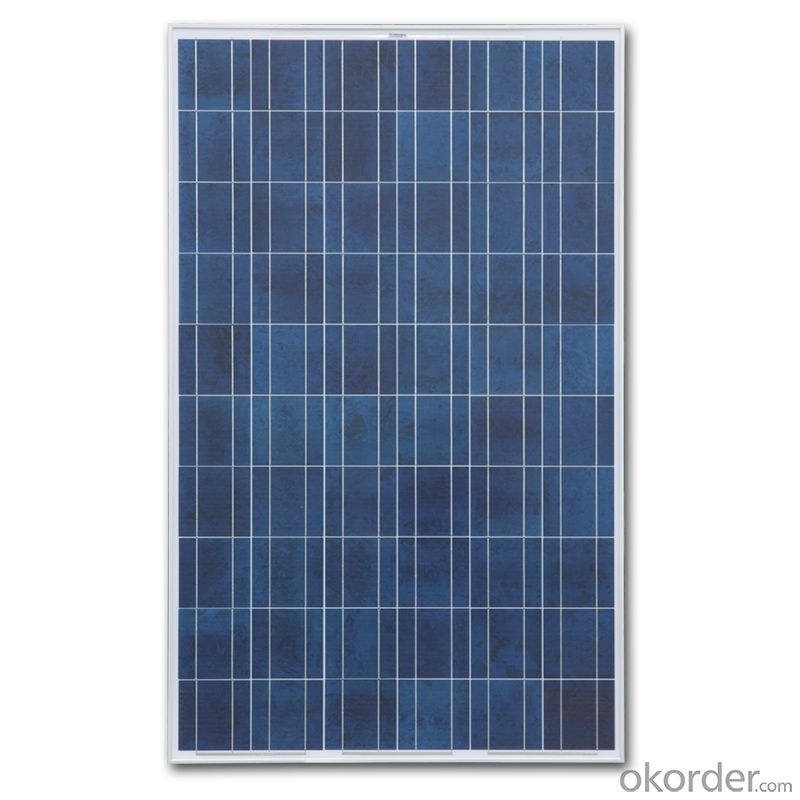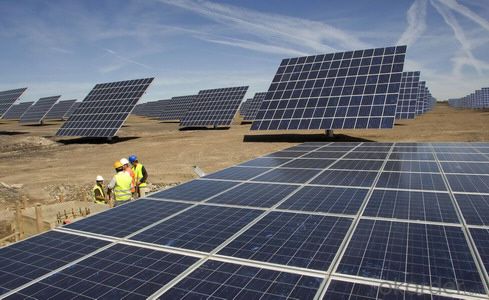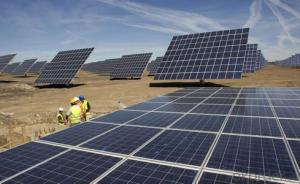Polycrystalline solar Panel of Best Price High Quality CNBM
- Loading Port:
- Qingdao
- Payment Terms:
- TT OR LC
- Min Order Qty:
- 10 set
- Supply Capability:
- 300000 set/month
OKorder Service Pledge
OKorder Financial Service
You Might Also Like
Polycrystalline Solar Modules
CNBM offers a range of small, medium and large polycrystalline solar modules, designed for a range of requirements.


Specifications:
Tolerance | +/-3% |
Cell | Polycrystalline silicon solarcells (156 x 156mm) |
N0. of Cells | 60 (0 x 6) |
Dimension of Modules (mm) | 1650 x 990 x 40 |
Weight (kg) | 25.5 |
Limits:
Operating Temperature | -40~+85? |
Storage Temperature | -40~+85? |
Maximum System Voltage | 1000 VDC max. |
Hail Impact | Diameter of 28mm with impact speed |
Temperature and Coefficients:
NOCT | 48C+/-2? |
Voltage temperature coefficient (%/K) | -0.35 |
Current temperature coefficient (%/K) | 0.05 |
Power temperature coefficient (%/K) | -0.45 |
Characteristics:
Model: | SGM-200P | SGM-210P | SGM-220P |
Max-power voltage Vmp (V) | 29.2 | 29.4 | 29.41 |
Max-power current Imp (A) | 6.85 | 7.14 | 7.48 |
Open-circuit voltage Voc (V) | 36.5 | 36.69 | 36.9 |
Short-Circuit Current Isc (A) | 7.28 | 7.6 | 7.93 |
Max-power Pm(W) | 200 | 210 | 220 |
Model: | SGM-230P |
Max-power voltage Vmp (V) | 29.8 |
Max-power current Imp (A) | 7.72 |
Open-circuit voltage Voc (V) | 37.31 |
Short-Circuit Current Isc (A) | 8.19 |
Max-power Pm(W) | 230 |
STC: Irradiance 1000W/m2, module temperature 25?, AM-=1.5
Poly Crystalline Solar Panels Specifications Range
Maximum Power (Pm) | Dimension | Weight | Operating Voltage (Vmp) | Operating Current (Imp) | Open Circuit Voltage (Voc) | Short Circuit Current (Isc) |
0.45W | 140x80x10mm | 0.08kg | 3.3V | 150mA | 4.6V | 160mA |
1.0W | 162x140x10mm | 0.16kg | 7.5V | 150mA | 10.3V | 160mA |
4.5W | 269x251x23mm | 0.8kg | 16.5V | 0.27A | 20.5V | 0.3A |
10W | 420.1×268.9×22.6mm | 1.92kg | 17.5V | 0.58A | 20.5V | 0.6A |
20W | 425x502x50mm | 3.0kg | 16.8V | 1.19A | 21.0V | 1.29A |
30W | 593x502x22.6mm | 3.9kg | 16.8V | 1.78A | 21.0V | 1.94A |
40W | 655x537x50mm | 5.75kg | 17.3V | 2.31A | 22.1V | 2.54A |
50W | 839x537x50mm | 6.0kg | 17.5V | 2.9A | 21.8V | 3.17A |
65W | 1111x502x50mm | 7.2kg | 17.6V | 3.69A | 22.1V | 3.99A |
80W | 1204x537x50mm | 7.7kg | 17.6V | 4.55A | 22.1V | 4.8A |
- Q:Can solar cells be used on airplanes?
- Yes, solar cells can be used on airplanes. In fact, solar-powered airplanes have been developed and successfully flown, demonstrating the feasibility of harnessing solar energy for aircraft propulsion. Solar cells can be integrated into the wings or body of the airplane to capture sunlight and convert it into electrical energy, reducing reliance on traditional fuel sources and making air travel more sustainable.
- Q:How do solar cells impact air pollution?
- Solar cells have a positive impact on air pollution as they produce clean and renewable energy, reducing the reliance on fossil fuels. By generating electricity from sunlight, solar cells help to decrease the emission of harmful pollutants and greenhouse gases that contribute to air pollution and climate change.
- Q:How do solar cells contribute to reducing carbon emissions?
- Solar cells contribute to reducing carbon emissions by converting sunlight into electricity without burning fossil fuels. As a clean and renewable energy source, solar cells help decrease the reliance on coal, oil, and gas power plants that emit greenhouse gases. By harnessing the sun's energy, they generate electricity with zero carbon emissions, thereby mitigating climate change and promoting a more sustainable future.
- Q:Can solar cells be used to power electronic devices?
- Yes, solar cells can be used to power electronic devices. Solar cells convert sunlight into electricity, which can be used to power a wide range of electronic devices such as calculators, smartphones, and even household appliances.
- Q:Can solar cells be used for powering schools?
- Yes, solar cells can be used for powering schools. Solar panels can be installed on the roofs of school buildings or in nearby areas to generate electricity from sunlight. This renewable energy source can help schools reduce their dependence on traditional power grids, lower energy costs, and contribute to a more sustainable and environmentally friendly campus.
- Q:How is the solar cells factories working in China? Do they follow certain quality standards?
- I know many good solar cell suppliers all over the world, and they are purchasing their solar cells product in China more and more.
- Q:How does solar cell technology apply to our daily life?
- Solar cells are used to make solar modules which generate electrical power from sunlight,
- Q:How much does a solar cell cost?
- Figuring out exactly the cost of the solar system you have can take a little detective work.
- Q:What is the impact of bird droppings on solar cell performance?
- Bird droppings can significantly impact solar cell performance by reducing the amount of sunlight reaching the surface of the cells. The droppings can act as a physical barrier, blocking sunlight and reducing the efficiency of the solar cells in converting sunlight into electricity. Additionally, the chemical composition of bird droppings can cause corrosion and damage to the surface of the cells, further degrading their performance over time. Regular cleaning and maintenance are essential to ensure optimal solar cell efficiency and prevent any long-term negative impact from bird droppings.
- Q:How are solar cells installed on rooftops?
- Solar cells are typically installed on rooftops using a mounting system that secures the panels in place. This involves attaching metal brackets or rails onto the roof, which act as the support structure for the solar panels. The panels are then placed onto these brackets and secured using clamps or screws. The installation process requires careful positioning and alignment to ensure maximum sunlight exposure for efficient energy generation.
1. Manufacturer Overview |
|
|---|---|
| Location | |
| Year Established | |
| Annual Output Value | |
| Main Markets | |
| Company Certifications | |
2. Manufacturer Certificates |
|
|---|---|
| a) Certification Name | |
| Range | |
| Reference | |
| Validity Period | |
3. Manufacturer Capability |
|
|---|---|
| a)Trade Capacity | |
| Nearest Port | |
| Export Percentage | |
| No.of Employees in Trade Department | |
| Language Spoken: | |
| b)Factory Information | |
| Factory Size: | |
| No. of Production Lines | |
| Contract Manufacturing | |
| Product Price Range | |
Send your message to us
Polycrystalline solar Panel of Best Price High Quality CNBM
- Loading Port:
- Qingdao
- Payment Terms:
- TT OR LC
- Min Order Qty:
- 10 set
- Supply Capability:
- 300000 set/month
OKorder Service Pledge
OKorder Financial Service
Similar products
New products
Hot products
Hot Searches
Related keywords


























